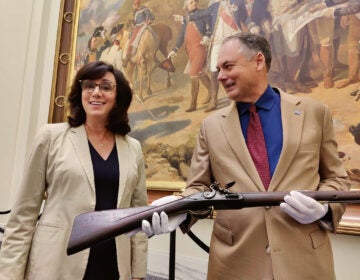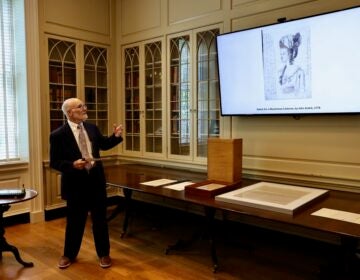‘It’s all about the story’: This drawing of the historic Bastille has led a historic life of its own
A sketch of the famed Paris fortress was made during its demolition by revolutionaries in 1789. Then it had a long, strange trip of its own.
From Philly and the Pa. suburbs to South Jersey and Delaware, what would you like WHYY News to cover? Let us know!
The drawing itself is not particularly arresting.
“The Destruction of the Bastille” is a yellowish ink wash sketch of the fortress in France, a symbol of royal tyranny, in the process of being dismantled stone-by-stone. In the foreground are well-dressed Parisians watching tiny stoneworkers in the distance do their work.
It’s not the composition that will draw collectors to an auction next month where “Bastille” is expected to bring an expected $500,000 – $800,000.
It’s the tangled tale wrapped around it.
“With no story, I see it in an antique shop for $250,” said Darren Winston, co-curator of books and manuscripts at Freeman’s | Hindman auctioneers in Philadelphia.
“It is absolutely the vessel by which the story comes,” he said. “It’s all about the story.”
The Destruction of the Bastille, now temporarily on view at the Museum of the American Revolution, was drawn from life about three weeks after French revolutionaries famously stormed the fortress prison on July 14, 1789, a date which has become a national holiday in France and, until recently, in Philadelphia.
The engineer overseeing the Bastille’s destruction, Étienne-Louis-Denis Cathala, took a moment to document the process on August 10, 1789.
For the next 235 years that drawing took a long, strange trip.
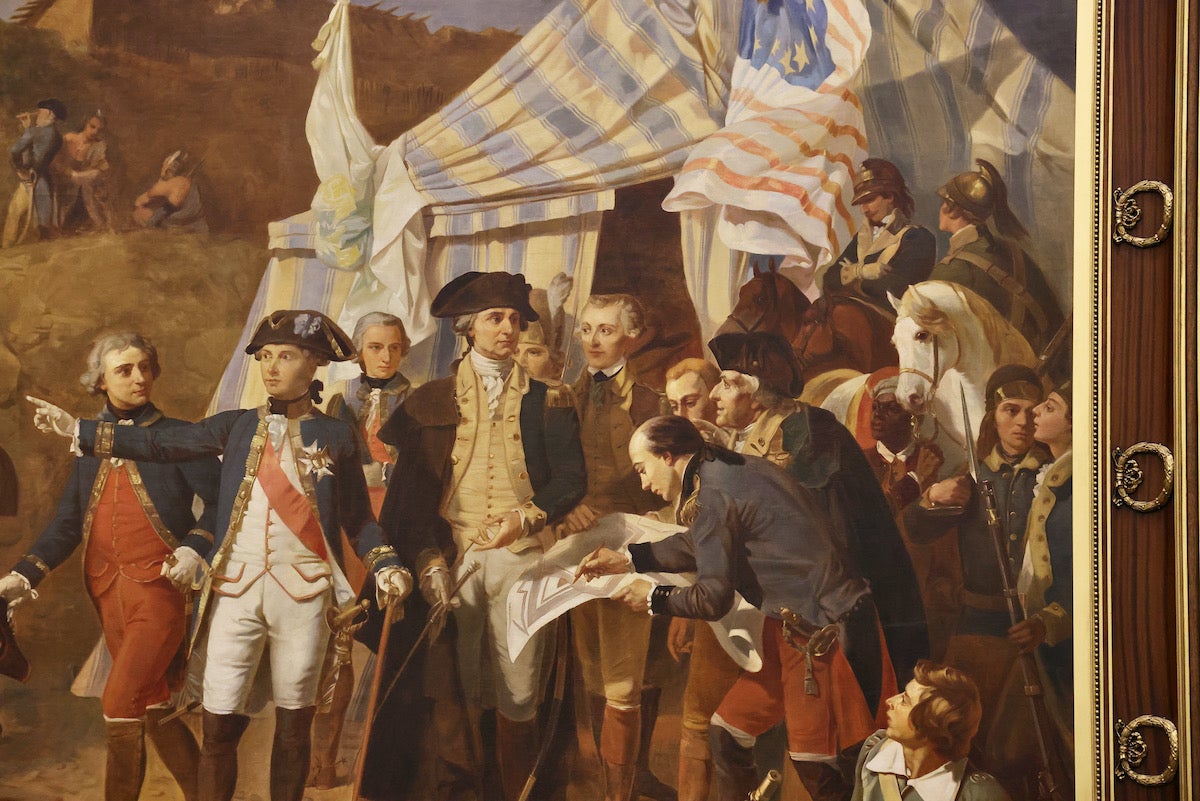
The Brotherhood of Generals
The person overseeing the demolition of the Bastille was The Marquis de Lafayette, who just a few years earlier was a hero of the American revolution as a protégé of General George Washington. He was famously wounded at the Battle of Brandywine, in Chadds Ford, Pennsylvania.
Having learned the grit of democratic revolution from Washington and then applied it to the revolution in his home country to topple the royal ruling class in France, Lafayette proudly presented his mentor with the drawing and the original key to the Bastille in 1790.
“It is a tribute, which I owe as a son to my adopted father,” Lafayette wrote in a note included with the gift. “As an aide de camp to my General, as a Missionary of liberty to its patriarch.”
Lafayette’s glowing admiration of Washington was no lip service: three months earlier he had begat a son, whom he named Georges Washington Lafayette. Washington displayed the key and the drawing in a place of prominence at his Mount Vernon estate.
“It perfectly encapsulated the relationship between the American Revolution and the French Revolution,” said James Taub, associate curator at the Museum of the American Revolution.
“This sketch was sent by The Marquis De Lafayette, ‘a hero of two worlds’ as they said at the time, to who he called ‘the patriarch of liberty,’” he said. “There are very few other objects in the world that still survive that perfectly encapsulate this connection between France and the United States.”
That connection alone is why Taub is thrilled to have it in his museum, however briefly.
“We love to share with people that the American Revolution is an international event,” he said. “It doesn’t just take place here.”
But the story of the drawing didn’t end there.
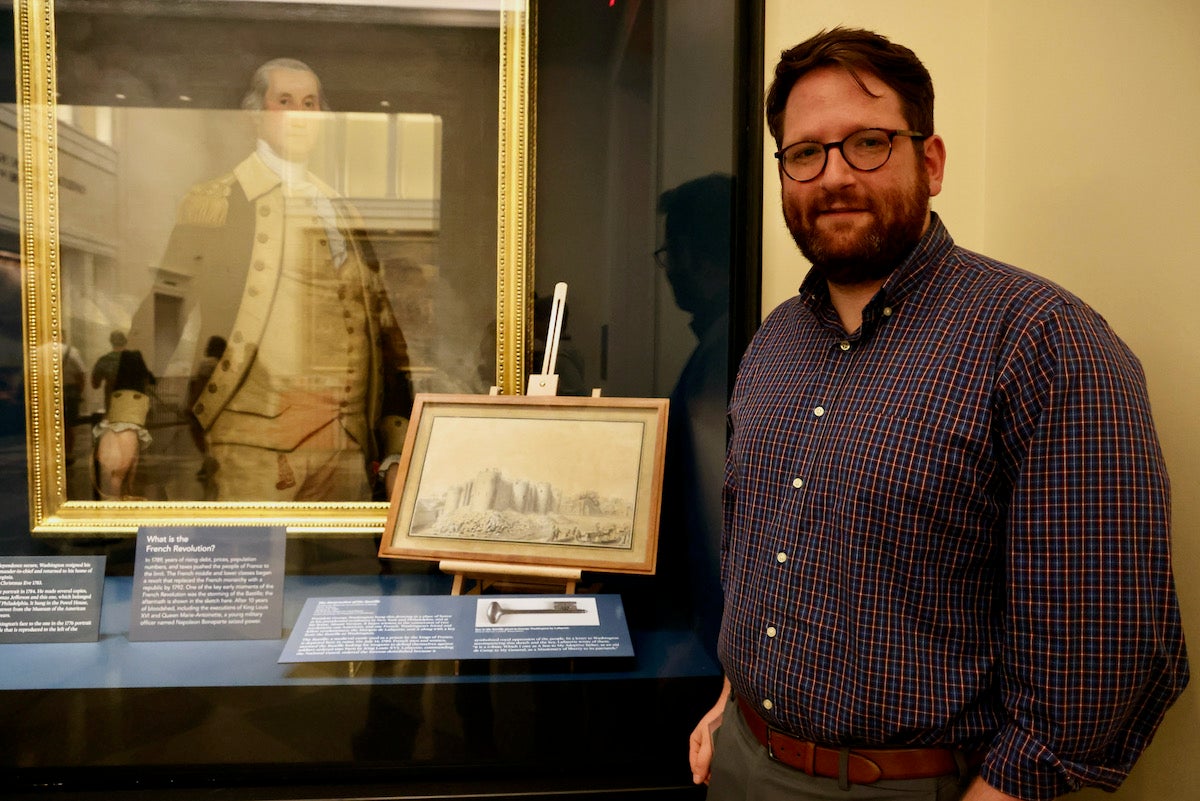
From Mount Vernon to a Brooklyn Warehouse to a Trailer Park
“The Destruction of the Bastille” remained in Mount Vernon for generations after George Washington’s death. Then in 1891 his descendants auctioned off most of the estate’s furnishings with the Philadelphia firm Thomas Birch Sons. The drawing went to William Benjamin, a collector and dealer of historic documents and papers.
Under historically unclear circumstances, Benjamin later sold the drawing to William Randolph Hearst, the wealthy and eccentric newspaper mogul who rabidly collected seemingly everything, including an entire Spanish monastery which was disassembled and delivered to a warehouse in Brooklyn, stone by stone, in 11,000 wooden crates.
Mixed in with that haul were other things Hearst collected, for unknown reasons, was the drawing. And this is where the tale takes a strange turn.
Hearst, financially struck down by the Great Depression, never got around to reassembling his monastery. The crates languished in the warehouse for decades, during which time they were intentionally set on fire.
“There was an outbreak of hoof and mouth disease,” said Winston, referring to the infection that spreads by cloven hoofed animals. “So they burned all of the packaging that all of those stones were in, all of the wood and straw, to get rid of any vestiges of the disease.”
To organize the stones after their crates were burned, stonemasons were called into the warehouse and marked them for how they should be ultimately assembled. One of those masons was Alan Carswell, who befriended the warehouse’s night watchman.
It is not known how the watchman came to possess the Bastille drawing – presumably he found it among the larger Hearst collection in storage – but he thought his stonemason friend would like a drawing of historic stonemasonry.
Carswell did like it and took it to his trailer home in Connecticut where he enjoyed it for the rest of his life, with the nagging suspicion that maybe he ought not have had it: in 1958 the Mount Vernon Ladies Association published an appeal for the missing drawing in the New York Times, asking for any tips on where it might be so it could be reunited with the historic Bastille key at Mount Vernon.
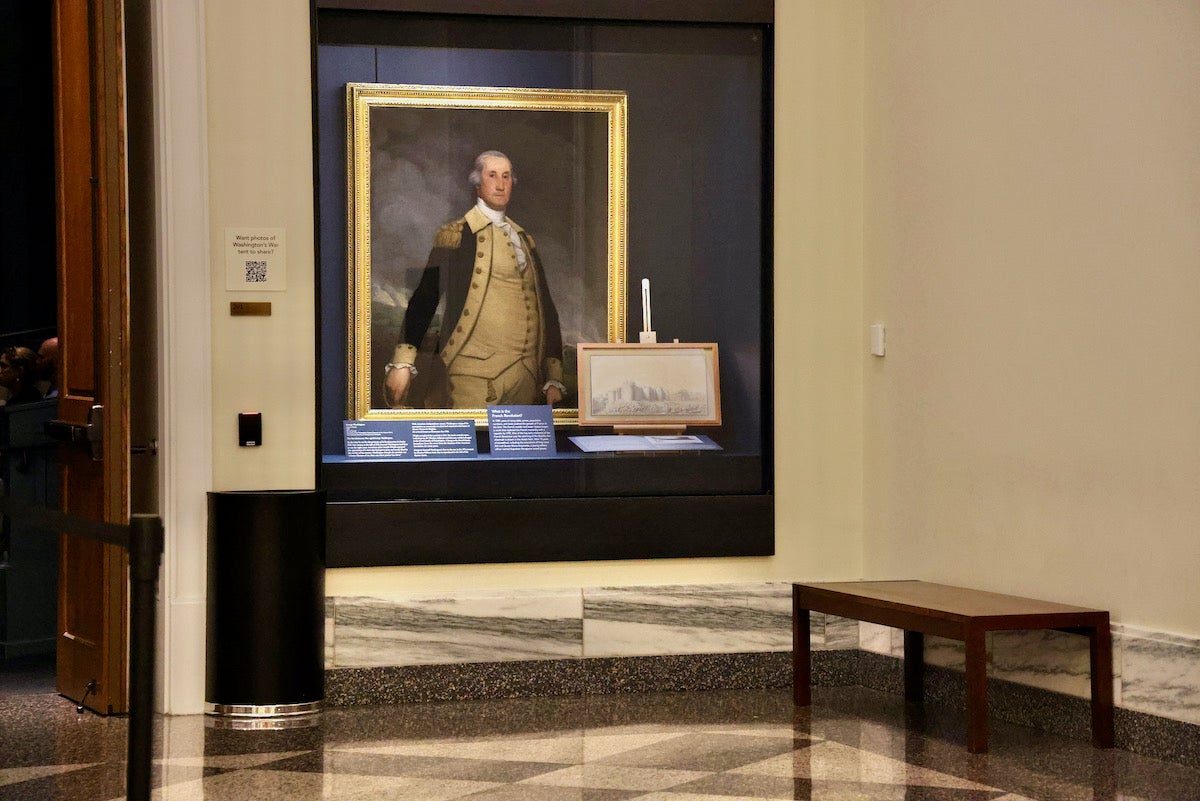
On to the Freemasons
After Carswell died in 1979 his wife wished the drawing should be returned to Mount Vernon, but after she died in 1984 the drawing got caught up in probate court and became part of the Mrs. Carswell’s bequest to the Masonic Charity Foundation of Connecticut and the Shrine’s Hospital for Crippled Children (an offshoot of the Freemasonry fraternity). The masons ultimately gave it to Mount Vernon on long-term loan in the 1980s.
Although reunited with the historic key to the Bastille at Mount Vernon, the historic site never owned the drawing.
Now the owners wish to sell “The Destruction of the Bastille.” They had Freeman’s take it away from Mount Vernon and set it out on a brief public tour through Paris, Chicago, New York, and Philadelphia.
Readying the Drawing for its Next Adventure
After it comes down at the Museum of the American Revolution on August 31 it will be put on display for a few days in Freeman’s New York City office, then returned to Philadelphia where Freeman’s will hold an auction on September 10.
The Museum of the American Revolution does not plan to bid on the object, even though the museum is planning a major exhibition in 2026 about the international influence of the American Revolution. It is unclear if the Mount Vernon historic site plans to bid, or to have a wealthy donor acquire the drawing on its behalf.
It is possible the drawing will be bought by a private collector and disappear from public view. But Winston says that is unlikely among collectors at this level, who are prepared to drop a quarter million dollars on a sketch.
“There are still people who want to buy that special thing and covet it, and that is their prerogative,” he said. “But I am very nicely surprised by the amount of people who will be up front and say, ‘I really want this because I want to share it.’ Making the decision to put it back on whatever course it was on.”

Get daily updates from WHYY News!
WHYY is your source for fact-based, in-depth journalism and information. As a nonprofit organization, we rely on financial support from readers like you. Please give today.



